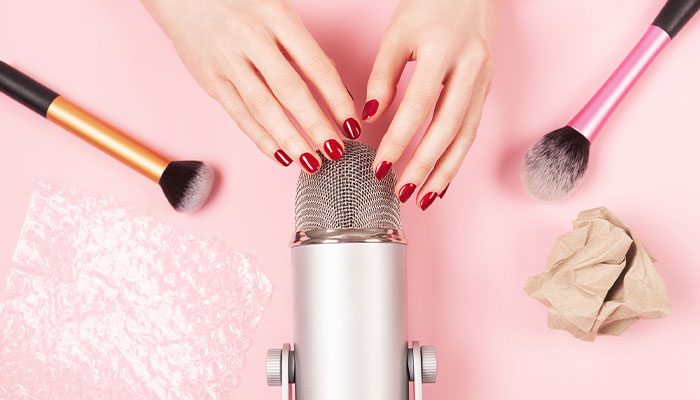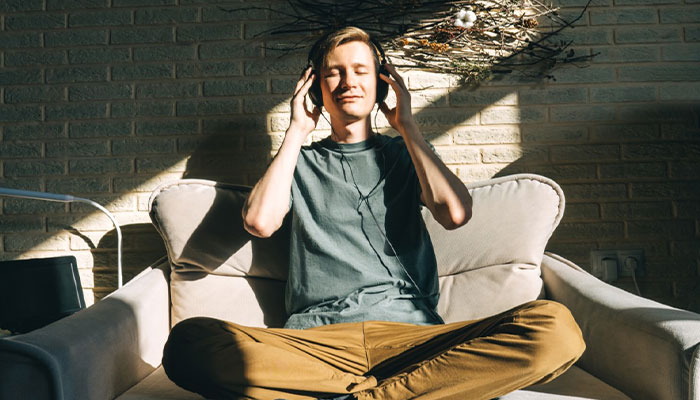ASMR is generally thought of as a tingling feeling or a sense of relaxation associated with specific types of sounds and images.

Sound scapes: ASMR stimuli come in many forms, but most fall within a fairly broad category of quiet, sharp sounds.
Originally, it was known colloquially as ‘Bob Ross phenomenon’, after the American painter and TV host, as people found calmness in the combination of his careful brush strokes and his voice as he described what he was doing.
The term ASMR was first coined in 2009, but the idea really exploded into the zeitgeist in 2019 with a Superbowl ad featuring actor Zoe Kravitz.
The ad combines many of the most popular forms of ASMR, as she whispers into a pair of microphones, flicks the top from a bottle of beer, taps her fingernails on the bottle, and pours the beer into a glass.
There are now tens of millions of pieces of ASMR content online, with thousands more added every day.
What does ASMR content look like?
ASMR stimuli come in many forms, but most fall within a fairly broad category of quiet, sharp sounds – tapping, gentle rasping sounds like a brush or sponge being stroked against a microphone, or crisp sounds like snapping a wafer biscuit or crunching paper.

Prime time: The idea of ASMR really exploded into the zeitgeist in 2019 with a Superbowl ad featuring actor Zoe Kravitz.
Whispering or soft speaking is popular, ranging from someone talking quietly about a topic they are interested in, to role play. Another common type involves thoughtful interaction with objects: wrapping presents, tracing a complex shape, or carving wax.
Outside these general areas, people may have very specific preferences, but ASMR can be almost anything that captures the attention and invites us to slow down and focus.
The other two dimensions are rarer: a feeling of intense happiness or euphoria, and an altered state of consciousness.
As a genre, it is closest to the ‘satisfying’ videos that many of us find so mesmerising. Satisfying content usually comes with a musical soundtrack and can range from someone icing a cake or blowing glass to melting wax, squishing slime, or even crushing objects with a mechanical press.
While these videos are satisfying to watch – and cause us to spend hours staring at a screen – ASMR stimuli differs in that it can produce a complex sensory and emotional response for some people.
What happens when people experience ASMR?
Through our research, we have identified four main dimensions to ASMR experiences. The most common dimensions are relaxation, making ASMR a popular way to fall asleep, and a tingling in the scalp that may travel down the spine.
People who feel the tingling sensation often say they have been experiencing it from as young as the age of six or seven, just from things they hear or see in everyday life.
The other two dimensions are rarer: a feeling of intense happiness or euphoria, and an altered state of consciousness, where people say they enter a trancelike state, and may even feel like time is slowing down.
Some have even reported feeling that they were ‘blending’ with the video and ‘melting’ into their chair.
Can anyone achieve ASMR?
It appears that not everyone can achieve the feelings associated with ASMR. About 29 per cent of the subjects in one of our recent studies reported feeling a tingling sensation after watching ASMR stimuli, and 23 per cent said they felt relaxation. Just 1 per cent said they reached an altered state of consciousness.

Noise works: ASMR experiences can leave people feeling comforted, and previous studies have found it can create feelings of connection for lonely people.
Our research has been focusing on trying to assess the ASMR experience, to understand what people are experiencing and create a self-reporting form to try to identify people who experience ASMR to be involved in further research.
From our findings, people who are likely to experience the more extreme dimensions of ASMR have a higher level of openness to experience, a trait associated with creative, empathetic people who feel things strongly – and may even be open to mystical experiences.
A role to play in health and wellbeing?
Previous research has found that ASMR may provide similar benefits to those seen from meditation and may be beneficial for people suffering from depression, chronic pain and even loneliness. One recent study found that half the people who felt relaxation and positive effects from ASMR content also reported an improvement in their mood.
Participants with depression reported a significant improvement in their depression score for at least three hours afterwards, and those with the most serious depression received the most benefit.
People suffering from chronic pain reported a similar effect. We also know that ASMR experiences can leave people feeling comforted, and previous studies have found it can create feelings of connection for lonely people. In one of our studies, we found ASMR may also be associated with greater feelings of self-worth and purpose.
ASMR is a relatively new area of research, so it is largely uncharted territory, but we are hopeful that we will have a much clearer idea of what it fully represents in the next few years.
Dr Natalie Roberts is a researcher at the Australian Institute of Health Innovation at Macquarie University



